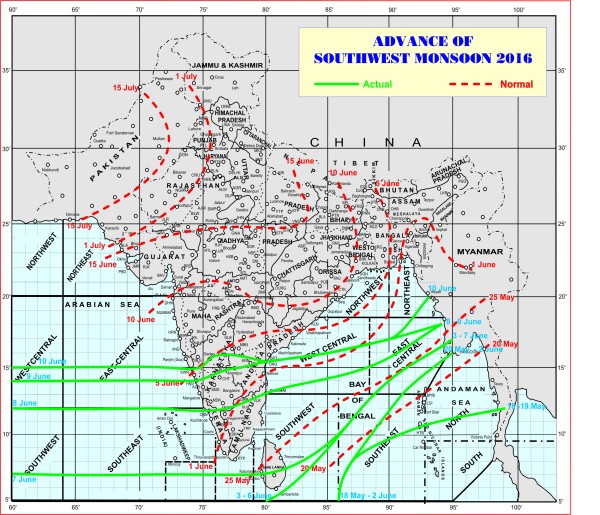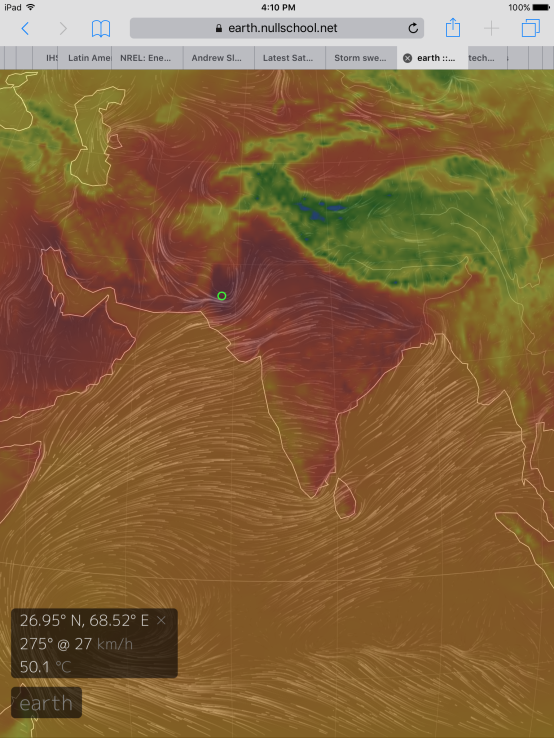India’s Monsoon is Delayed For Third Year in a Row — Climate Change is Likely Cause
“It
has been observed that since 2001, places in northern India,
especially in Rajasthan, are witnessing a rising temperature trend
every year. The main reason is the excessive … emission of carbon
dioxide.”
— Laxman Singh Rathore, the director general of the
India Meteorological Department.
*****
10
June, 2016
The
reduction in India’s monsoon rains is a big deal. It generates
systemic drought, creates a prevalence for heatwaves, and locally
amplifies the impacts of human-caused climate change. For three years
now, the Indian monsoon has been delayed. India
is experiencing its worst heatwaves ever recorded and
water shortages across the country are growing dire. The monsoonal
rains are coming, again late. And people across India — residents
as well as weather and climate experts — are beginning to wonder if
the endemic drought and heat stress will ever end.
Historically,
there was only one climate condition known to bring about a delay in
India’s Monsoon — El Nino. And last year, a strong El Nino is
thought to have contributed both to the Monsoon’s late arrival and
to a very severe drought that is now gripping the state. What the
2015 El Nino cannot also account for is the 2014 delay and weakening
of monsoonal rains. And during 2016, as India’s monsoon has again
been held back by 1-2 weeks, and El Nino is now but a memory, it’s
beginning to become quite clear that there’s something else
involved in the weakening of India’s annual rains.
Indian
Monsoon Delayed Third Year in a Row
(Onset
of the Indian Monsoon has been delayed for three years in a row now.
A condition likely caused by a human-forced warming of the world and
one that is worsening an extreme drought and heatwave situation
across the country. Image source: The
India Meteorological Department.)
As
of today, the eastern edge of the Southeast Asian monsoon had only
advanced to the middle of Myanmar. This late progress is two weeks
behind the typical advance of the monsoon in this part of the world
at this time of year. Further west, the monsoon has extended somewhat
futher — only trailing the typical monsoon’s advance by 5 days
along the western coast of India.
With
La Nina blooming in the Eastern Pacific, there’s no other
climatological excuse for this delay. The El Nino influence is mostly
gone. And all that’s left is a global climate context in which
temperatures have now risen to around 1.3 C hotter than 1880s
averages.
Climate
Change is Likely Cause
Scientific
studies modeling the impacts of human-forced warming have long found
that heating the Earth atmosphere resulted in an eventual delay and
weakening of the Indian monsoon. A study published last year
in Geoscience
Frontiers continued
this line of study. Global Circulation Model (GCM) runs found that
the Indian monsoon was expected to be delayed by 15 days on
average during
the 21st Century due to human caused climate change. That
the amount of precipitation provided by the monsoon would be reduced
by about 70 percent.
And that the eastern section of the monsoon would tend to be subject
to greater delays than the west.
(Extreme
heat in the range of 45 to 51 degrees Celsius [113 to 124 degrees
Fahrenheit] is expected to continue to impact a broad region of
Northern India and Eastern Pakistan tomorrow. These temperatures are
in record ranges and threaten
to again break the all-time hottest temperatures ever recorded in
India this week.
By now, the onset of monsoonal rains should be taking the edge off a
good portion of this heat. But a monsoon apparently delayed by a
human forced warming of the world still holds back its cooling loads
of moisture. Image source: Earth
Nullschool.)
Delays
in the Indian Monsoon result in a loss of precipitation due to the
fact that the duration of the event is greatly reduced. Rainfall has
to therefore be more intense over a shorter period of time in order
to make up for losses. Increasing drought prevalence results in
further moisture losses due to a kind of atmospheric heat and dryness
barrier that tends to sap storms of precipitation even as they start
to form. The
net result for India is a prediction of severe moisture loss due to
human-caused climate change.
This
year’s India monsoonal delay — as with the delay during 2014 —
falls into that pattern. And the massive drought that India is now
experiencing as a result appears to be emerging from a set of
atmospheric conditions that are consistent with human-caused climate
change. India’s risk for continued drought and increasingly extreme
heatwaves over the coming years is therefore on the rise.
And it is
yet to be seen if this year’s monsoon will deliver the hoped-for
and desperately-needed relief. Already, the rain-bearing storm system
is lagging. And that’s not a good sign.
Links:






No comments:
Post a Comment
Note: only a member of this blog may post a comment.